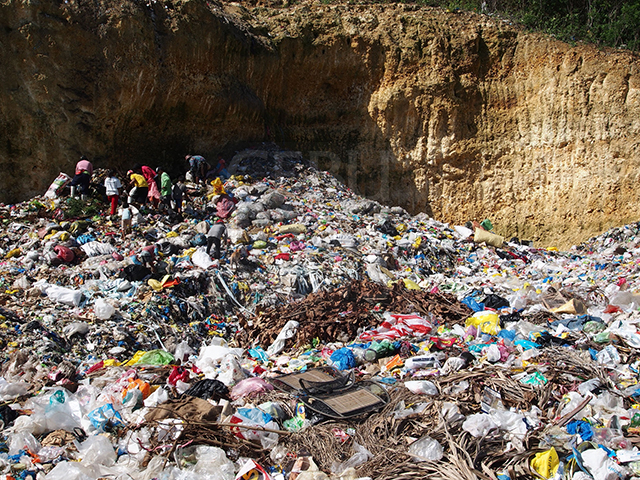‘No fund’ for sanitary landfill in Compostela, Bogo City

SCAVENGERS. rummage through piles of trash at the dumpsite in Compostela, Cebu. (CDN PHOTO/CHRISTIAN MANINGO)
The local governments of Compostela town and Bogo City pointed to lack of fund as the reason for their failure to construct sanitary landfills.
The two local government units were among the about 600 LGUs in the country that the Office of the Ombudsman would be investigating for allegedly failing to shut down open dumps in their jurisdictions.
The investigation was based on a complaint filed last Wednesday by the National Solid Waste Management Commission (NSWMC) against mayors, vice mayors, and councilors in these LGUs, including mayors Joel Quiño of Compostela and Celestino “Junie” Martinez of Bogo.
Quiño told Cebu Daily News by phone on Friday that they were doing everything they could to dispose of the town’s wastes in accordance with Republic Act No. 9003 (Ecological Solid Waste Management Act), but they did not have the estimated P20 million needed to build a garbage landfill.
“If we rate solid waste management in the town, I can say I am not that satisfied. We lack facilities because we lack funds,” he said.
Under RA 9003, open dumpsites are no longer allowed and should be replaced with sanitary landfills and material recovery or recycling facilities.
But Quiño said his municipality only generates P70 million to P80 million a year from local taxes and from its internal revenue allocation (IRA) share, and there was nothing to spare to build a sanitary landfill.
Wilfredo Hinoguin, the Municipal Solid Waste Management officer, insisted, however, that they were not operating an open dump but a “materials recovery facility” (MRF) that doubled as a “mini-dumpsite” since the town’s dump site was shut down last year.
“I don’t know why we were included (in the complaint since) we filed a closure plan,” he added.
The town’s MRF, which sits on a 9,000-square-meter lot in Barangay Cambayog, is 500 meters away from the open dumpsite owned by a private firm that the Department of Environment and Natural Resources in Central Visayas shut down in 2015 due to numerous violations.
Hinoguin said the town’s MRF could process 15 to 18 tons of garbage daily. The recycled materials are turned into vases or home decor by members of the community.
Only non-biodegradable items or residual waste were now being brought to the mini-dumpsite for processing, he added.
An MRF usually receives biodegradable waste for composting and mixes non-biodegradable wastes for final segregation, re-use and recycling, provided that each type of mixed waste is collected from the source and transported to the plant in separate containers.
Among the non-biodegradable materials processed by the MRF, which are taken from households, are plastics, cardboard, paper, and metal scraps.
To address the lack of funds, Hinoguin said Compostela is currently in talks with private firms for the construction of a 10-ha to 15-ha sanitary landfill.
In the proposed landfill, methane can be extracted from waste materials, turned into power and supplied to the Cebu Electric Cooperative (Cebeco).
Bogo City has, meanwhile, begun constructing a sanitary landfill in an 8-ha land in Barangay Lapas, but the P8 million allocated for the project was not even half of the P20 million needed to build the facility, said City Administrator Max Suico.
“If we build it by phase, (we can fund) the construction. (But) I don’t think it’s possible to shell out money for the whole thing (all at once),” he said.
The P8 million was used for clearing operations and buying the equipment for garbage collection and compacting, he said.
Bogo City’s Environment and Natural Resources Officer Wenceslao Cañete Jr. said the city operated an open dump until it was closed in mid-2015.
The city’s sanitary landfill site, about 5 km from the old site, is now being used as a “temporary dumpsite.”
“The new site is already being used, but we wouldn’t call it compliant to the rules yet. That’s why we will be doing work on it next week,” said Cañete.
The Cebu Provincial Board approved in December last year over P26 million in cash assistance to LGUs for them to construct MRFs, but officials of both Bogo and Compostela said they have yet to receive their share of the fund.
Cebu environmental lawyer Benjamin Cabrido, meanwhile, echoed calls for LGUs to stop allowing open dump, noting that the NSWMC was passed in 2001 and yet several LGUs refused to comply with its provisions.
“This issue (closure of open dumpsites) is long overdue. The law has been there for several years now. There can never be any justification as to why there are still LGUs which do not follow the law,” he added “I hope our local executives will comply with the provisions of the law against open dumps. Otherwise, all of us will suffer its consequences,” Cabrido said over the phone on Friday.
Disclaimer: The comments uploaded on this site do not necessarily represent or reflect the views of management and owner of Cebudailynews. We reserve the right to exclude comments that we deem to be inconsistent with our editorial standards.




